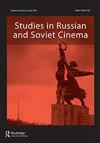Men out of focus: the Soviet masculinity crisis in the long sixties
IF 0.4
0 FILM, RADIO, TELEVISION
引用次数: 2
Abstract
of their greater number, even though their contributions to what the authors call women’s cinema may not be any less consequential. Indeed, the conversation about gender issues and what women’s cinema is begins in the introduction of Chapter 1. The authors argue and convincingly illustrate throughout the book that ‘animation made by women was and is gendered’ (5) and that animations made by women depict opinions on important feminine problems. They effectively prove that these twelve female directors shaped the notion of female subjectivity in Soviet animation. Finally, the book positions animation as more than simply being of interest to children and places it in the broader context of Soviet and post-Soviet cinema and culture generally. The book is not without a few minor flaws. For example, it is unclear why the authors do not use a soft sign in their transliterations, which is quite eye-catching for Russian speakers. Similarly, Chapter 1 would be better identified as an introduction because it functions as such: the book’s layout would have been more consistent and logical. Nevertheless, She animates productively ‘begins a dialogue about women animators, preserving their legacy through the concept of women’s cinema’ (193). Michele Leigh and Lora Mjolsness have done a great job highlighting women’s directorial voices together with feminine aesthetics and Soviet and Russian female subjectivity. This interdisciplinary volume is an important and much-needed contribution to animation, gender and women’s studies.男性失焦:六十年代的苏联男性危机
尽管她们对作者所说的女性电影的贡献可能不会减少。事实上,关于性别问题和什么是女性电影的讨论始于第一章的引言。作者在整本书中论证并令人信服地说明,“女性制作的动画过去和现在都是性别化的”(5),女性制作的动画片描绘了对重要女性问题的看法。她们有效地证明了这十二位女性导演塑造了苏联动画中女性主体性的概念。最后,这本书将动画定位为不仅仅是儿童感兴趣的东西,并将其置于苏联和后苏联电影和文化的更广泛背景下。这本书并非没有几个小毛病。例如,目前尚不清楚作者为什么不在音译中使用软符号,这对讲俄语的人来说非常引人注目。同样,第1章最好被确定为引言,因为它的功能是这样的:这本书的布局会更加一致和合乎逻辑。尽管如此,她还是富有成效地制作了动画,“开始了一场关于女性动画师的对话,通过女性电影的概念保留了她们的遗产”(193)。米歇尔·利和洛拉·姆约尔内斯在突出女性导演声音、女性美学和苏俄女性主体性方面做得很好。这本跨学科的书是对动画、性别和妇女研究的重要和急需的贡献。
本文章由计算机程序翻译,如有差异,请以英文原文为准。
求助全文
约1分钟内获得全文
求助全文

 求助内容:
求助内容: 应助结果提醒方式:
应助结果提醒方式:


